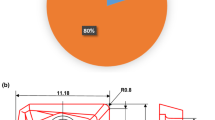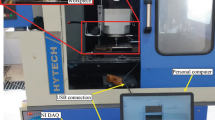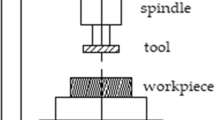Abstract
Inconel 718 possesses exceptional properties that negatively affect tool life and other key indicators of the cutting mechanism. Owing to the unprecedented failure states of carbide inserts under the synergistic impact of processing conditions and the complex superalloy’s metallurgical properties, the imagery signals contain smeared noise, which affects the predictive efficiency of data analytics during tool condition monitoring (TCM). Previous studies applied image processing techniques, such as edge segmentation, detection, auto-encoders, textural, fractal, Fourier, and wavelet analysis, to extract features from tool wear signals despite being inefficient under complex wear morphology. Therefore, this study applies a more efficient data-mining analytic called the multi-sectional singular value decomposition (multi-sectional SVD) for dimensionality reduction and extraction of features from the complex imagery signals, enhancing the predictive efficiency of machine learning (ML) during TCM. To achieve this, an interrupted climb-milling of Inconel 718 was conducted at various speeds, feeds, and axial depth of cut to generate the dataset through the in-process acquisition of tool wear images, as well as measurement of the progressive VB for the PVD-TiAlN/NbN-coated carbide inserts. Then, the multi-sectional SVD-based ML was employed to process the imagery signals and extract latent features that combined with process parameters to predict VB. After validating the predicted against the actual VB values, the model yielded a mean average percentage error (MAPE) of 2.36%, indicating its effectiveness in predicting VB profile under complex flank wear morphology. Furthermore, the system was utilized to design an effective cutting condition, where the multi-stage adjustment of speed and feed was employed to reduce the VB rate in the early cutting stage.















Similar content being viewed by others
Data availability
The data used in this manuscript is available from the corresponding author and can be accessed on reasonable request.
Code availability
Not applicable.
References
Polvorosa R, A Suárez L. de Lacalle, I. C.-J. of M, undefined 2017, Tool wear on nickel alloys with different coolant pressures: comparison of Alloy 718 and Waspaloy, Elsevier, Accessed: Sep. 01, 2020. [Online]. Available: https://www.sciencedirect.com/science/article/pii/S1526612517300129
Anderson M, Patwa R, Shin YC (2006) Laser-assisted machining of Inconel 718 with an economic analysis. Int J Mach Tools Manuf 46(14):1879–1891. https://doi.org/10.1016/j.ijmachtools.2005.11.005
Banda T, Jie BYW, Farid AA, Lim CS (2022) Machine vision and convolutional neural networks for tool wear identification and classification 737–747. https://doi.org/10.1007/978-981-33-4597-3_66.
Wu X, Liu Y, Zhou X, Mou A (2019) Automatic identification of tool wear based on convolutional neural network in face milling process. Sensors (Switzerland) 19(18). https://doi.org/10.3390/s19183817.
ISO 8688-1: (1989) (E) Tool life testing in milling - Part 1: face milling. International organization for standardization
Banda T, Liu Y, Farid AA, Lim CS (2023) A machine learning model for flank wear prediction in face milling of Inconel 718. Int J Adv Manuf Technol. https://doi.org/10.1007/s00170-023-11152-3
Banda T, Jauw VL, Farid AA, Wen NH, Xuan KCW, Lim CS (2023) In-process detection of failure modes using YOLOv3-based on-machine vision system in face milling Inconel 718. Int J Adv Manuf Technol 3885–3899. https://doi.org/10.1007/s00170-023-12168-5.
Ong P, Lee WK, Lau RJH (2019) Tool condition monitoring in CNC end milling using wavelet neural network based on machine vision. Int J Adv Manuf Technol 104(1–4):1369–1379. https://doi.org/10.1007/s00170-019-04020-6
Zhu K (2022) Machine vision based smart machining system monitoring. 267–295. https://doi.org/10.1007/978-3-030-87878-8_8
Pontevedra V et al (2018) ScienceDirect ScienceDirect ScienceDirect Tool wear prediction in end milling of Ti-6Al-4V through Kalman Tool wear prediction in end milling of Ti-6Al-4V through Kalman filter based fusion of International texture features and cutting forces filter based. Procedia Manuf 26:1459–1470. https://doi.org/10.1016/j.promfg.2018.07.095
Castejón M, Alegre E, Barreiro J, Hernández LK (2007) On-line tool wear monitoring using geometric descriptors from digital images. Int J Mach Tools Manuf 47(12–13):1847–1853. https://doi.org/10.1016/j.ijmachtools.2007.04.001
Prasad KN, Ramamoorthy B (2001) Tool wear evaluation by stereo vision and prediction by artificial neural network. J Mater Process Technol 112(1):43–52. https://doi.org/10.1016/S0924-0136(00)00896-7
Wu X, Liu Y, Zhou X, Mou A (2019) Automatic identification of tool wear based on convolutional neural network in face milling process. Sensors (Switzerland) 19(18). https://doi.org/10.3390/s19183817
Banda T, Lestari V, Chuan J, Ali L, Farid A, Seong C (2022) Flank wear prediction using spatial binary properties and artificial neural network in face milling of Inconel 718. Int J Adv Manuf Technol 0123456789. https://doi.org/10.1007/s00170-022-09039-w
Banda T, Ho KY, Akhavan Farid A, Lim CS (2021) Characterization of tool wear mechanisms and failure modes of TiAlN-NbN coated carbide inserts in face milling of Inconel 718. J Mater Eng Perform no. Ref 10. https://doi.org/10.1007/s11665-021-06301-2
Li L, An Q (2016) An in-depth study of tool wear monitoring technique based on image segmentation and texture analysis. Meas J Int Meas Confed 79:44–52. https://doi.org/10.1016/j.measurement.2015.10.029
Devillez A, Lesko S, Mozer W (2004) Cutting tool crater wear measurement with white light interferometry. Wear 256(1–2):56–65. https://doi.org/10.1016/S0043-1648(03)00384-3
Karthik A, Chandra S, Ramamoorthy B, Das S (1997) 3D tool wear measurement and visualisation using stereo imaging. Int J Mach Tools Manuf 37(11):1573–1581. https://doi.org/10.1016/S0890-6955(97)00023-0
Banda T, Farid AA, Li C, Jauw VL, Lim CS (2022) Application of machine vision for tool condition monitoring and tool performance optimization–a review. Int J Adv Manuf Technol 121(11):7057–7086. https://doi.org/10.1007/s00170-022-09696-x
Kolev V, Tsvetkova K, Tsvetkov M (2010) Singular value decomposition of images from scanned photographic plates. VII Serbian-Bulgarian Astron Conf SBAC 2010(11):187–200
Sadek RA (2020) SVD based image processing applications: state of the art, contributions and research challenges, 2012. [Online]. Available: www.ijacsa.thesai.org. Accessed: Sep. 06, 2020
Andrews HC, Patterson CL (1976) Singular value decompositions and digital image processing. IEEE Trans Acoust 24(1):26–53. https://doi.org/10.1109/TASSP.1976.1162766
Konstantinides K, Natarajan B, Yovanof GS (1997) Noise estimation and filtering using block-based singular value decomposition. IEEE Trans Image Process 6(3):479–483. https://doi.org/10.1109/83.557359
Anowar F, Sadaoui S, Selim B (2021) Conceptual and empirical comparison of dimensionality reduction algorithms (PCA, KPCA, LDA, MDS, SVD, LLE, ISOMAP, LE, ICA, t-SNE). Comput Sci Rev 40. https://doi.org/10.1016/j.cosrev.2021.100378
Cirillo MD, Mirdell R, Sjöberg F, Pham TD (2019) Tensor decomposition for colour image segmentation of burn wounds. Sci Rep 9(1):1–13. https://doi.org/10.1038/s41598-019-39782-2
Kaya B, Oysu C, Ertunc HM (2011) Advances in Engineering Software Force-torque based on-line tool wear estimation system for CNC milling of Inconel 718 using neural networks. Adv Eng Softw 42(3):76–84. https://doi.org/10.1016/j.advengsoft.2010.12.002
Faghih Dinevari V, Karimian Khosroshahi G, Zolfy Lighvan M (2016) Singular value decomposition based features for automatic tumor detection in wireless capsule endoscopy images. Appl Bionics Biomech 2016. https://doi.org/10.1155/2016/3678913
Liu J, Niu X, Kong W (2006) Image watermarking based on singular value decomposition. Proc. - 2006 Int. Conf. Intell. Inf. Hiding Multimed. Signal Process. IIH-MSP. 457–460. https://doi.org/10.1109/IIH-MSP.2006.265040
Arif J, Chaudhuri NR, Ray S, Chaudhuri B (2009) Online Levenberg-Marquardt algorithm for neural network based estimation and control of power systems. Proc Int Jt Conf Neural Networks 199–206. https://doi.org/10.1109/IJCNN.2009.5179071
Thakre AA, Lad AV, Mala K (2019) Measurements of Tool wear parameters using machine vision system. https://doi.org/10.1155/2019/1876489
Mikołajczyk T, Nowicki K, Kłodowski A, Pimenov DY (2016) Neural network approach for automatic image analysis of cutting edge wear. Mech Syst Signal Process 88:100–110. https://doi.org/10.1016/j.ymssp.2016.11.026
Ezugwu EO, Wang ZM, Machado AR (2000) Wear of coated carbide tools when machining nickel (Inconel 718) and titanium base (Ti-6A1-4V) alloys. Tribol Trans 43(2):263–268. https://doi.org/10.1080/10402000008982338
De Melo ACA, Milan JCG, Da Silva MB, Machado ÁR (2006) Some observations on wear and damages in cemented carbide tools. J Brazilian Soc Mech Sci Eng 28(3):269–277. https://doi.org/10.1590/s1678-58782006000300004
Acknowledgements
The authors express their sincere gratitude for the financial support received from the University of Nottingham Malaysia (UNM), Semenyih, Malaysia, and the Malawi University of Business and Applied Sciences (MUBAS), Blantyre, Malawi.
Author information
Authors and Affiliations
Contributions
All authors contributed to the conceptual idea of the manuscript. The first draft of the manuscript was written by Dr. Tiyamike Banda. All authors commented on the previous versions. Dr. Veronica Lestari Jauw, Assoc. Prof. Ali Akhavan Farid, Prof. Chuan Li, and Assoc. Prof. Chin Seong Lim supervised, reviewed, and edited the manuscript. All authors read and finally approved the final version of the manuscript.
Corresponding author
Ethics declarations
Ethics approval
Not applicable because this article does not contain any studies with human or animal subjects.
Consent to participate
Not applicable.
Consent for publication
Not applicable.
Competing interests
The authors declare no competing interests.
Additional information
Publisher's Note
Springer Nature remains neutral with regard to jurisdictional claims in published maps and institutional affiliations.
Rights and permissions
Springer Nature or its licensor (e.g. a society or other partner) holds exclusive rights to this article under a publishing agreement with the author(s) or other rightsholder(s); author self-archiving of the accepted manuscript version of this article is solely governed by the terms of such publishing agreement and applicable law.
About this article
Cite this article
Banda, T., Jauw, V.L., Li, C. et al. Multi-sectional SVD-based machine learning for imagery signal processing and tool wear prediction during CNC milling of Inconel 718. Int J Adv Manuf Technol (2024). https://doi.org/10.1007/s00170-024-13610-y
Received:
Accepted:
Published:
DOI: https://doi.org/10.1007/s00170-024-13610-y




